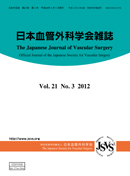Volume 21, Issue 3
Displaying 1-16 of 16 articles from this issue
- |<
- <
- 1
- >
- >|
Orignal Article
-
2012 Volume 21 Issue 3 Pages 165-173
Published: May 01, 2012
Released on J-STAGE: May 15, 2012
Download PDF (3841K)
-
2012 Volume 21 Issue 3 Pages 177
Published: May 01, 2012
Released on J-STAGE: May 15, 2012
Download PDF (215K)
-
2012 Volume 21 Issue 3 Pages 269-
Published: May 01, 2012
Released on J-STAGE: May 15, 2012
Download PDF (365K) -
2012 Volume 21 Issue 3 Pages 270-
Published: May 01, 2012
Released on J-STAGE: May 15, 2012
Download PDF (364K) -
2012 Volume 21 Issue 3 Pages 271-
Published: May 01, 2012
Released on J-STAGE: May 15, 2012
Download PDF (390K) -
2012 Volume 21 Issue 3 Pages 280-
Published: May 01, 2012
Released on J-STAGE: May 15, 2012
Download PDF (371K) -
2012 Volume 21 Issue 3 Pages 285-
Published: May 01, 2012
Released on J-STAGE: May 15, 2012
Download PDF (55K) -
2012 Volume 21 Issue 3 Pages 291-
Published: May 01, 2012
Released on J-STAGE: May 15, 2012
Download PDF (784K) -
2012 Volume 21 Issue 3 Pages 302-
Published: May 01, 2012
Released on J-STAGE: May 15, 2012
Download PDF (816K) -
2012 Volume 21 Issue 3 Pages 319-
Published: May 01, 2012
Released on J-STAGE: May 15, 2012
Download PDF (589K) -
2012 Volume 21 Issue 3 Pages 329-
Published: May 01, 2012
Released on J-STAGE: May 15, 2012
Download PDF (1125K) -
2012 Volume 21 Issue 3 Pages 363-
Published: May 01, 2012
Released on J-STAGE: May 15, 2012
Download PDF (1838K) -
2012 Volume 21 Issue 3 Pages 445-
Published: May 01, 2012
Released on J-STAGE: May 15, 2012
Download PDF (2138K) -
2012 Volume 21 Issue 3 Pages 543-
Published: May 01, 2012
Released on J-STAGE: May 15, 2012
Download PDF (443K) -
2012 Volume 21 Issue 3 Pages 549-
Published: May 01, 2012
Released on J-STAGE: May 15, 2012
Download PDF (2138K) -
2012 Volume 21 Issue 3 Pages 563-
Published: May 01, 2012
Released on J-STAGE: May 15, 2012
Download PDF (652K)
- |<
- <
- 1
- >
- >|
